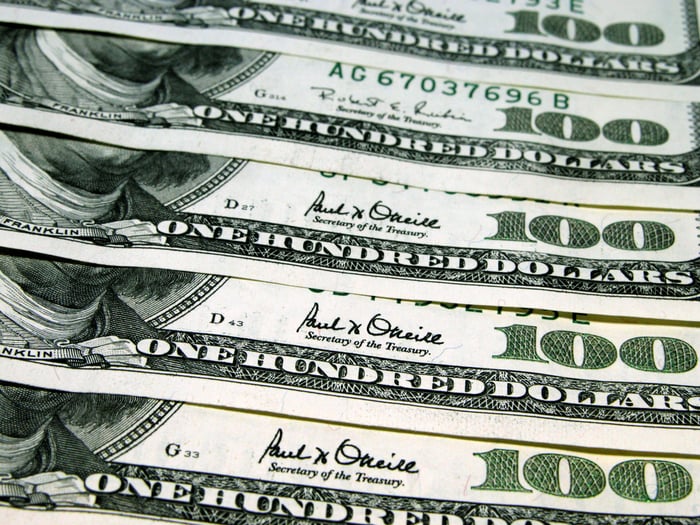Although Wall Street offers few guarantees, history has consistently shown that dividend stocks stand head and shoulders above their competition.
Back in 2013, J.P. Morgan Asset Management, the wealth management division of banking giant JPMorgan Chase, released a report that compared the annualized performance of publicly traded companies initiating and growing their payouts to companies that didn't offer a dividend. The span of this comparison was 40 years (1972-2012).
According to the report, the annualized return for dividend stocks was 9.5% over four decades. Meanwhile, the non-payers generated a menial 1.6% annualized return over the same timeline. Unsurprisingly, time-tested companies that are profitable on a recurring basis tend to outperform.

Image source: Getty Images.
However, not all dividend stocks are cut from the same cloth. For example, Dividend Kings are truly in a class of their own. These are income stocks that have raised their base annual payout for at least 50 consecutive years. At the moment, only around four dozen stocks qualify as Dividend Kings.
If you want to generate $500 in super safe annual dividend income, investing $9,900 in the following three Dividend Kings (split equally), which average a 5.07% yield, would be a smart way to do it.
Altria Group: 8.27% yield
The first Dividend King that can provide exceptionally safe dividend income is tobacco stock Altria Group (MO -0.37%). Although adult smoking rates have been declining in the U.S. since the mid-1960s, Altria has tricks up its sleeve to keep its profit needle and current 8.3% annual payout moving in the right direction.
While it would certainly be ideal to see cigarette shipment volume increasing, improved awareness about the adverse health effects of smoking have led to a steady decline in adult smoking rates. However, Altria's pricing power hasn't suffered one bit. The addictive nature of nicotine, which is found in tobacco products, has created an inelasticity to Altria's pricing strategy. In other words, it's been able to raise prices on its tobacco products -- especially its premium Marlboro brand -- with virtually no pushback from consumers.
But it's the company's ancillary operating segments that are truly intriguing. While selling tobacco cigarettes should remain its core cash-flow driver for a long time to come, Altria is investing heavily in smoke-free alternatives.
For instance, Altria hasn't been shy about its desire to become a core player in the vape market. It recently closed its acquisition of NJOY for $2.75 billion, which may include up to $500 million in additional contingency payments. The NJOY Ace is the only pod-based electronic vapor product that's received marketing authorization from the U.S. Food and Drug Administration.
Furthermore, Altria has a stellar capital-return program. It's repurchased $3.5 billion worth of its common stock since the start of 2021, and it's increased its base annual payout for 53 consecutive years. Management is aiming for single-digit annual payout growth through 2028.
AbbVie: 4.18% yield
A second Dividend King that can help you bring home $500 in annual dividend income from a $9,900 initial investment (split equally, three ways) is pharmaceutical company AbbVie (ABBV -4.58%).
The biggest risk for AbbVie is that it generates a sizable percentage of net sales from a single drug: Humira. With the exception of COVID-19 vaccines, Humira has been the world's top-selling brand-name therapeutic. However, the good news for AbbVie is that we've seen internal innovation and acquisitions result in a more diversified product portfolio and revenue stream over time.
As biosimilar competition for Humira heats up globally, AbbVie will be looking to two other immunology blockbusters to pick up the slack: Skyrizi and Rinvoq. On an operating basis, excluding currency movements, Skyrizi and Rinvoq delivered 46% and 51% respective year-over-year sales growth in the March-ended quarter. AbbVie anticipates combined peak sales of the two drugs will top $21 billion by 2027, which would more than offset the impact of biosimilars on Humira.
Beyond innovation, AbbVie hasn't been afraid to grow through acquisitions. In May 2020, it completed a $63 billion deal to acquire Allergan. This buyout brought blockbuster drug Botox into the fold, as well as major depressive disorder treatment Vraylar. Respectively, Botox and Vraylar are on pace to top $5 billion and $2 billion in sales this year.
Similar to Altria Group, AbbVie is quite generous with its capital-return program. The company's board has overseen $5.35 billion in aggregate share buybacks since the start of 2020. Further, it's increased its base annual payout, which currently sits at about 4.2%, in each of the past 51 years.

Image source: Getty Images.
Johnson & Johnson: 2.76% yield
The third Dividend King that can help you generate $500 in annual dividend income from an initial investment of $9,900 (split equally, three ways) is healthcare conglomerate Johnson & Johnson (JNJ -0.46%), which is better known as "J&J."
Arguably the biggest headwind for J&J is the uncertain financial liability it may face from litigation tied to its now-discontinued talcum-based baby powder. Although the company proposed an $8.9 billion settlement in April, it's not clear if this figure is enough to put the matter in the rearview mirror.
But regardless of what the ultimate settlement figure turns out to be, Johnson & Johnson will have no trouble meeting its financial obligations. According to Standard & Poor's (S&P), a division of the more-familiar S&P Global, J&J is one of only two publicly traded companies to earn its top credit rating (AAA). This means S&P has more faith in J&J servicing and repaying its outstanding debt than it does of the U.S. government (AA credit rating) doing the same.
What allows Johnson & Johnson to flourish is its revenue mix. For over a decade, it's been shifting more of its net sales toward pharmaceuticals, which provide considerably juicier margins than its other segments. To counter the possibility of future patent cliffs, J&J has aggressively reinvested in its pipeline, formed a number of drug-development collaborations, and hasn't been afraid to make the occasional acquisition.
To boot, Johnson & Johnson has one of the world's leading medical technology segments. As medical-care access improves globally, an aging population should provide a path for J&J's MedTech devices to meaningfully grow.
Although J&J's yield is a "pedestrian" 2.8%, keep in mind the company's board has increased its base annual payout for 61 consecutive years. Over the past half-century, J&J's annualized total return is a cool 11.4%, which is more than enough to make patient investors notably richer.





